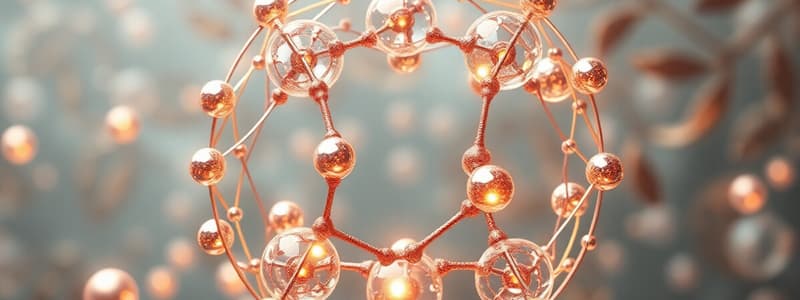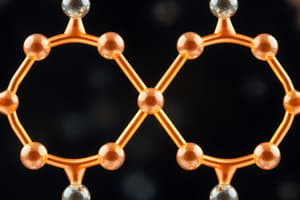Podcast
Questions and Answers
What are valence electrons?
What are valence electrons?
- Electrons located in the innermost energy level
- Electrons in the nucleus of an atom
- Electrons that are involved in chemical bonding (correct)
- Electrons that do not participate in bonding
Which type of bond involves the sharing of electrons between atoms?
Which type of bond involves the sharing of electrons between atoms?
- Covalent bond (correct)
- Ionic bond
- Hydrogen bond
- Metallic bond
What is a characteristic of ionic compounds?
What is a characteristic of ionic compounds?
- They consist entirely of nonmetals
- They have high melting points and are crystalline (correct)
- They are always liquid at room temperature
- They are formed by the sharing of electrons
How is a double bond formed?
How is a double bond formed?
What distinguishes a polar covalent bond from a nonpolar covalent bond?
What distinguishes a polar covalent bond from a nonpolar covalent bond?
How do valence electrons influence the reactivity of elements?
How do valence electrons influence the reactivity of elements?
What is the primary characteristic of ionic bonds?
What is the primary characteristic of ionic bonds?
When writing chemical formulas for ions, which order is correct?
When writing chemical formulas for ions, which order is correct?
What holds covalent bonds together?
What holds covalent bonds together?
What describes how metal atoms are bonded together?
What describes how metal atoms are bonded together?
What defines an ion?
What defines an ion?
Which of the following ions is formed when metals lose electrons?
Which of the following ions is formed when metals lose electrons?
What is the main reason an atom would seek to lose or gain electrons?
What is the main reason an atom would seek to lose or gain electrons?
Which of the following statements about anions is true?
Which of the following statements about anions is true?
Which of the following best describes the charge of cations?
Which of the following best describes the charge of cations?
What does a subscript in a chemical formula indicate?
What does a subscript in a chemical formula indicate?
Which part of a chemical formula is used to represent the number of molecules?
Which part of a chemical formula is used to represent the number of molecules?
How are elements represented in a chemical formula?
How are elements represented in a chemical formula?
What is the purpose of parentheses in a chemical formula?
What is the purpose of parentheses in a chemical formula?
In the chemical formula $H_2O$, how many hydrogen atoms are present?
In the chemical formula $H_2O$, how many hydrogen atoms are present?
Which characteristic is typical of ionic bonds?
Which characteristic is typical of ionic bonds?
What happens to ionic compounds when they are melted or dissolved in water?
What happens to ionic compounds when they are melted or dissolved in water?
Which of the following statements describes metallic bonds?
Which of the following statements describes metallic bonds?
How do covalent bonds generally differ from ionic bonds?
How do covalent bonds generally differ from ionic bonds?
Which of the following is a property of covalent compounds?
Which of the following is a property of covalent compounds?
What is the correct chemical formula for the compound formed by combining Sodium (Na) and Chromium (Cr)?
What is the correct chemical formula for the compound formed by combining Sodium (Na) and Chromium (Cr)?
What is the correct chemical formula for the compound formed from Magnesium (Mg) and phosphorus (P)?
What is the correct chemical formula for the compound formed from Magnesium (Mg) and phosphorus (P)?
What is the correct chemical formula for the compound formed by combining Potassium (K) and Sulfate (SO₄)?
What is the correct chemical formula for the compound formed by combining Potassium (K) and Sulfate (SO₄)?
What is the correct chemical formula for the compound formed from Aluminum (Al) and iodine (I)?
What is the correct chemical formula for the compound formed from Aluminum (Al) and iodine (I)?
What is the correct chemical formula for the compound formed by combining Copper (Cu) and Nitrate (NO₃)?
What is the correct chemical formula for the compound formed by combining Copper (Cu) and Nitrate (NO₃)?
Which compound is classified as covalent?
Which compound is classified as covalent?
Which of the following compounds contains a polyatomic ion?
Which of the following compounds contains a polyatomic ion?
What type of bond is present in FeCl₃?
What type of bond is present in FeCl₃?
Which of the following compounds is a covalent bond?
Which of the following compounds is a covalent bond?
Identify the classification of Na₂CO₃.
Identify the classification of Na₂CO₃.
What is the molecular formula of chlorine when constructed using Lewis Dot Diagrams?
What is the molecular formula of chlorine when constructed using Lewis Dot Diagrams?
How many bonds does nitrogen typically form in order to satisfy the octet rule?
How many bonds does nitrogen typically form in order to satisfy the octet rule?
Which component is essential to include when drawing a Lewis Dot Diagram for a molecule?
Which component is essential to include when drawing a Lewis Dot Diagram for a molecule?
What arrangement does hydrogen exhibit in a Lewis Dot Diagram?
What arrangement does hydrogen exhibit in a Lewis Dot Diagram?
In the process of constructing molecular formulas, which step follows drawing the Lewis Dot Diagrams?
In the process of constructing molecular formulas, which step follows drawing the Lewis Dot Diagrams?
Which statement best describes a covalent bond?
Which statement best describes a covalent bond?
What is the Lewis Dot Diagram primarily used to represent?
What is the Lewis Dot Diagram primarily used to represent?
According to the Octet Rule, how many valence electrons do most atoms strive to achieve?
According to the Octet Rule, how many valence electrons do most atoms strive to achieve?
How many bonds does nitrogen normally form in covalent compounds?
How many bonds does nitrogen normally form in covalent compounds?
What are lone pairs in a Lewis Dot Structure?
What are lone pairs in a Lewis Dot Structure?
In the molecule carbon dioxide (CO2), how many total bonding pairs are involved?
In the molecule carbon dioxide (CO2), how many total bonding pairs are involved?
What is the role of bonding pairs in covalent bonding?
What is the role of bonding pairs in covalent bonding?
What behavior does hydrogen exhibit in relation to bonding?
What behavior does hydrogen exhibit in relation to bonding?
Flashcards
Valence electrons and reactivity
Valence electrons and reactivity
The number of valence electrons in an atom determines how it will bond with other atoms, which affects its reactivity.
Valence Electrons
Valence Electrons
Electrons in the outermost energy level of an atom.
Chemical Bond
Chemical Bond
The attractive force holding atoms together.
Ionic bonds
Ionic bonds
Signup and view all the flashcards
Ionic Bond
Ionic Bond
Signup and view all the flashcards
Covalent bonds
Covalent bonds
Signup and view all the flashcards
Ionic Compound
Ionic Compound
Signup and view all the flashcards
Metal bonding
Metal bonding
Signup and view all the flashcards
Covalent Bond
Covalent Bond
Signup and view all the flashcards
Chemical equations
Chemical equations
Signup and view all the flashcards
What is an ion?
What is an ion?
Signup and view all the flashcards
Why do atoms gain or lose electrons?
Why do atoms gain or lose electrons?
Signup and view all the flashcards
What are the two types of ions?
What are the two types of ions?
Signup and view all the flashcards
What creates a cation?
What creates a cation?
Signup and view all the flashcards
What creates an anion?
What creates an anion?
Signup and view all the flashcards
Chemical Formula
Chemical Formula
Signup and view all the flashcards
Chemical Symbol
Chemical Symbol
Signup and view all the flashcards
Coefficient
Coefficient
Signup and view all the flashcards
Subscript
Subscript
Signup and view all the flashcards
Parenthesis in Formulas
Parenthesis in Formulas
Signup and view all the flashcards
Binary Compound
Binary Compound
Signup and view all the flashcards
What is the formula for lithium bromide?
What is the formula for lithium bromide?
Signup and view all the flashcards
What is the formula for magnesium sulfide?
What is the formula for magnesium sulfide?
Signup and view all the flashcards
What makes ionic compounds hard & brittle?
What makes ionic compounds hard & brittle?
Signup and view all the flashcards
Why do ionic compounds conduct electricity when melted or dissolved?
Why do ionic compounds conduct electricity when melted or dissolved?
Signup and view all the flashcards
Covalent bonds - what are they like?
Covalent bonds - what are they like?
Signup and view all the flashcards
How do metals conduct electricity?
How do metals conduct electricity?
Signup and view all the flashcards
Metallic bonds - what are they?
Metallic bonds - what are they?
Signup and view all the flashcards
Polyatomic Ion
Polyatomic Ion
Signup and view all the flashcards
Compound Containing a Polyatomic Ion
Compound Containing a Polyatomic Ion
Signup and view all the flashcards
Classifying Bonds
Classifying Bonds
Signup and view all the flashcards
Lewis Dot Diagram
Lewis Dot Diagram
Signup and view all the flashcards
Octet Rule
Octet Rule
Signup and view all the flashcards
Bonding Pairs
Bonding Pairs
Signup and view all the flashcards
Lone Pairs
Lone Pairs
Signup and view all the flashcards
How many bonds does carbon form?
How many bonds does carbon form?
Signup and view all the flashcards
What does the 1-2-3-4 rule tell you?
What does the 1-2-3-4 rule tell you?
Signup and view all the flashcards
Why does hydrogen behave like a halogen?
Why does hydrogen behave like a halogen?
Signup and view all the flashcards
Molecular Formula
Molecular Formula
Signup and view all the flashcards
How to Draw a Lewis Dot Diagram for Chlorine?
How to Draw a Lewis Dot Diagram for Chlorine?
Signup and view all the flashcards
What is the Molecular Formula for Ammonia?
What is the Molecular Formula for Ammonia?
Signup and view all the flashcards




